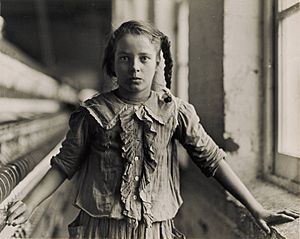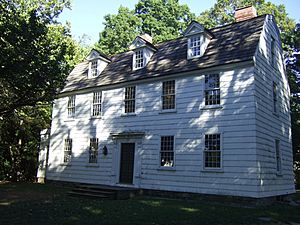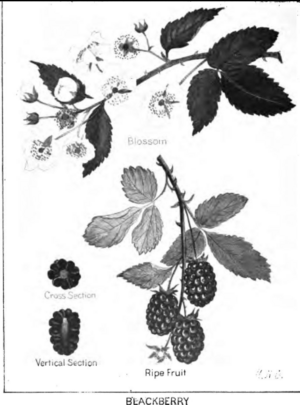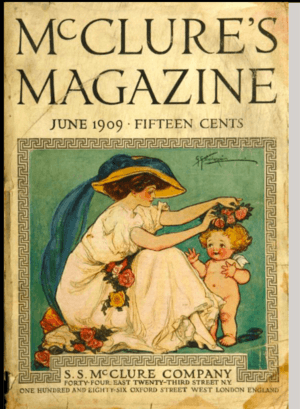Marion Hamilton Carter facts for kids
Quick facts for kids
Marion Hamilton Carter
|
|
|---|---|
| Born | April 9, 1865 |
| Died | March 12, 1937 |
| Education | |
| Occupation |
|
Marion Hamilton Carter (1865-1937) was an American writer, teacher, and journalist. She lived during the Progressive Era, a time when many people worked to improve society. Marion was a muckraker, which means she was a journalist who investigated and exposed problems in society. She also supported women getting the right to vote. Today, she is best known for her novel about women's suffrage, The Woman With Empty Hands: The Evolution of a Suffragette.
Contents
Early Life and Family
Marion Hamilton Carter was born in Philadelphia, Pennsylvania, in 1865. She was the oldest of three children. Her family was well-off. Her father, Dr. Charles Carter, was a surgeon who served in the U.S. Navy. Her mother, Mary Nelson Bunker, was from Fairfield, Connecticut.
The Carter family spent their summers in Fairfield, Connecticut, at a house that used to be a colonial inn called the Sun Tavern. Marion's mother was also a writer. She published a book of stories about life in the Appalachia region of North Carolina.
Education and Learning
Marion Carter and her younger sister Kathleen received a strong science education in Philadelphia. This helped them get into top women's colleges. Marion attended several colleges, including Vassar College, Massachusetts Institute of Technology (MIT), Radcliffe College, and Cornell University.
In 1892, Marion wanted to study psychology at Harvard University. However, Harvard did not accept women students at that time. So, she went to Radcliffe College instead. While studying, she invented 75 paper dolls for schools. These dolls were meant to help children with creative writing.
Teaching Career
By the time she was 34, Marion Carter had taught children for eleven years. She also continued her own studies. In 1899, she taught at the New York Teacher Training School. She even gave lectures on topics like the psychology of fear.
In 1904, Marion wrote an article called "The Parent." In it, she shared her experiences with different types of parents. She admitted that she did not enjoy teaching very much. After 1904, she left teaching to become a writer and journalist. She also wrote a letter to The New York Times about the unhealthy air quality at the New York Teacher Training School. She mentioned that many students got sick with a serious lung illness.
During her time teaching, Marion published seven books. One was a teaching guide about nature study, which included her own drawings of plants. The other six were children's animal stories.
Influence of William James
Marion Carter was in touch with her former professor, William James. He was a famous psychologist. Marion saw him as a close friend and respected his work. She suffered from depression throughout her life. She said that James's writings helped her during difficult times. His ideas also influenced her later work.
Investigative Journalism
Marion Carter became a well-known muckraker journalist in the early 1900s. She wrote for popular magazines like McClure's. She often investigated important issues.
Views on Education
In 1899, Carter wrote a controversial article about kindergarten. She said it turned children into "prigs" and "sentimentalists." Her article caused a big debate among teachers. Years later, she continued to criticize kindergarten, calling it "Infant Vaudeville" and even "one of the most insidiously immoral institutions in the country."
Views on Alcohol Laws
In 1905, Carter wrote a letter to The New York Times. She asked women to protest a law that banned selling alcohol in Army canteens. This law was an early step towards Prohibition (banning alcohol). Carter argued that the law was unfair and driven by a few unhappy women who supported women's suffrage.
Reporting on Legal Cases
Marion Carter gained a reputation as a muckraking journalist by covering the 1906 Josephine Terranova murder trial. Seventeen-year-old Josephine had killed her aunt and uncle after years of abuse. The case was unusual because the defense argued that Josephine heard voices. Carter focused on Josephine's mental state.
Science and Health Reporting
In 1909, McClure's magazine asked Carter to investigate two diseases common among the poor in South Carolina: pellagra and hookworm.
She wrote about pellagra, a disease linked to a poor diet. She explained its history and how it was affecting many people. She also reported on hookworm, a parasitic infection. Her article described the problem in detail.
Child Labor Reporting

In 1913, Carter wrote a letter to The New York Times about child labor. She had investigated cotton mills in South Carolina in 1909. She controversially claimed that working in these mills was better for children than attending schools in New York. She said mill children were better fed, housed, and educated than their rural peers. This view was strongly criticized by others.
Magazine Editor
Marion Carter worked as an editor for McClure's magazine from late 1909 to 1910. She often wrote articles without her name on them or used a fake name.
After leaving McClure's, Carter planned to launch her own women's magazine called The Woman's Era. She wanted it to be a high-quality magazine "by women for women." She aimed to hire famous women writers and make it like a "Woman's McClure." However, it seems this new magazine was never actually published.
Fiction Writing
Short Stories
In 1909, Marion Carter was hired to write short stories for a new children's page called "For Every Boy and Girl." She published many short stories between 1905 and 1922 in popular magazines like The Saturday Evening Post and Collier's. Many of her stories were set in Wyoming. She had traveled there in 1911 to interview Judge Mary A. Garrett, who was believed to be the first woman justice of the peace in the United States.
Novels
The Woman With Empty Hands: The Evolution of a Suffragette In 1913, Carter published her novel The Woman With Empty Hands: The Evolution of a Suffragette. It was published anonymously, meaning her name was not on it. The book is dedicated to Emmeline Pankhurst, a famous British suffragette.
The story is written as if it's a true autobiography. It tells the story of a wealthy widow who feels lost after her family dies. She finds new purpose by joining the women's suffrage movement. The book shows her journey from a grieving woman to a strong supporter of women's right to vote. It uses ideas from Marion's friend, William James, to show the character's inner growth. The story was meant to persuade readers to support women's suffrage.
Souls Resurgent Carter's second novel, Souls Resurgent, was published in 1916. The story is set in Wyoming ranch country. It explores ideas about family background and character.
Later Years and Legacy
In 1922, Marion Carter moved to Christiantown, Massachusetts, on Martha's Vineyard. She had loved the area since she was a child. She bought an old house in the woods and lived there alone until she died.
Marion Hamilton Carter passed away on March 12, 1937, just before her 72nd birthday. She left her property in Christiantown to Cornell University. She also left her art collection, including paintings and sculptures, to Vassar College. Her work shows the journey of many women journalists in the early 1900s who also became novelists.
Published Works
Books
- Nature Study with Common Things: an Elementary Laboratory Manual. New York: American Book Company, 1904.
Editions
- Panther Stories: Retold from St. Nicholas Magazine. New York: D. Appleton Century Company, 1904.
Journals and Magazines (Selected)
- "The Kindergarten Child – after the Kindergarten." The Atlantic Monthly, March 1899.
- "The Parent." McClure’s Magazine, November 1904.
- "The Conservation of the Defective Child." McClure’s Magazine, June 1909.
- "The Vampire of the South." McClure’s Magazine, October 1909.
- "Pellagra: the Medical Mystery of To-day." McClure’s Magazine, November 1909.
- Anonymous. "The Autobiography of a Small Wyoming Homesteader." The Saturday Evening Post, November 25, 1911.




